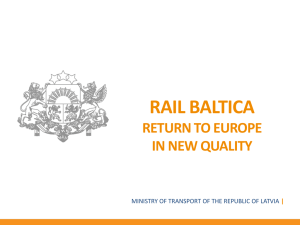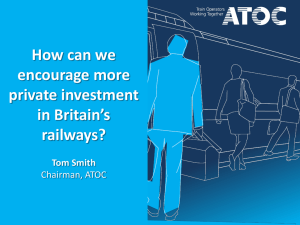Intro to Rail Transportation 2
advertisement
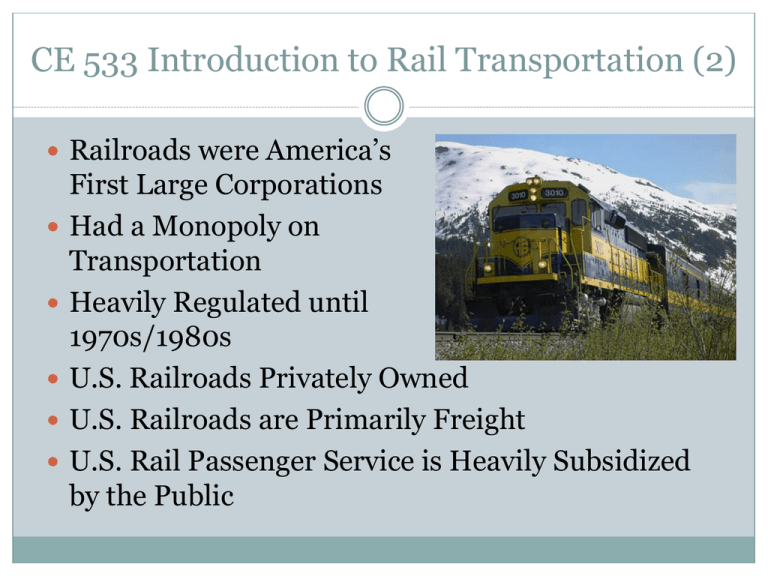
CE 533 Introduction to Rail Transportation (2) Railroads were America’s First Large Corporations Had a Monopoly on Transportation Heavily Regulated until 1970s/1980s U.S. Railroads Privately Owned U.S. Railroads are Primarily Freight U.S. Rail Passenger Service is Heavily Subsidized by the Public Introduction • Adequate Transportation System • Efficient Movement of Goods and People • Provides No Basic Intrinsic Value • Provides “Value Added” • Necessary for Economy and Development Early Modes of Transportation in the U.S. • • • • • Waterways Crude Roads Rivers/Canals 1700’s Railroads 1830 Better Roads Trucks/Automobiles early 1920’s • Air – Passengers 1950s • Interstates Trucks/Automobiles early 1960s • Railroads 2000s!!! Current Modes of Transportation in the U.S. • Highway Trucks • Waterways • Pipeline • Airways • Conveyor Belts • Railways Why is railroad freight transport so important now, and even more so in the future? • Lets consider the alternatives for inland transport: truck, water, air, pipeline, conveyor belt 5 Waterways Pros and Cons • Pros: Energy efficiency, low cost, low pollution, safety, capacity • Cons: Speed, limited network 6 Highway Truck Pros and Cons • Pros: Speed, reliability, network coverage • Cons: Energy efficiency, safety, land use, pollution, cost, congestion (because of shared use of infrastructure truck transport affects auto safety and congestion as well) How many truckloads can a railcar carry? 7 Airways Pros and Cons Pros: Speed, reliability, network coverage Cons: Energy efficiency, cost, limited volume Pipelines and Conveyor Belts • Pros: High volume, continuous transport possible, no vehicles needed, low labor requirements • Cons: Highly constrained types of commodities, limited product flexibility, speed and network 9 Rail uniquely combines speed and energy efficiency *Plus environmentally Friendly 10 Rail is the principal means of economically moving large, heavy freight long distances overland Freight 11 North American freight transportation volume by mode Billions of Ton-Miles 1600 1400 1200 1000 800 600 400 200 0 Rail Truck Truck Pipeline Pipeline Waterways Waterways Source: AAR from Eno Foundation for Transportation Air Air 2000 1800 Revenue Ton-Miles (billions) 1600 US rail freight traffic 1400 1200 1000 800 600 400 200 0 1920 1930 1940 1950 1960 1970 Year 1980 1990 2000 2005 2008 Common Goals & Functions of the Railroad Industry • The movement of Freight • Characteristics and People in the most – Fast efficient manner possible – Reliable • Principal Function in U.S. – Convenient – Hauling Freight (~43+%) – – – – Economical Safe/Secure Fuel Efficient Environmentally Friendly • Renewed Interest in Passenger Rail Early Regulations Land Grants (1850-1870) Business Transactions Development of Central and Western U.S. Repaid Interstate Commerce Commission (1887) Surface Transportation Board (1995-1996) Recent Significant Legislation • Phase 1: – 1971 Amtrak – 1983 RRB / Depreciation • Phase 2: – 1973 3R Act – 1976 4R Act – 1980 Staggers (Deregulation) • Phase 3: – – – – – 1992 ISTEA 1998 T21 2004 SAFETEA-LU 2008 Safety Improvements 2010 Surface Transportation Assistance Act The Fundamental Principle of Rail Transport - EFFICIENCY Implications for Economics, Energy & Environment or Why Rail Transport is More Important Than Ever! 18 US 20th Century was about CONVENIENCE The 21st must consider EFFICIENCY as well • • Then – Abundant: energy, land, natural resources and labor Now – Diminishing resources: • Energy • Air quality • Water • Land – Congestion • Need more efficient use of transportation infrastructure – Stronger global competition 19 RESISTANCE (lbs./ton) Speed and Resistance by Transport Mode Boat Airplanes Trucks Rail uniquely combines High Speed and Low Resistance SPEED (mph) 20 Lower coefficient of rolling friction (μR) • Steel wheel on steel rail has lower rolling friction (μR) than rubber tire on pavement: – Steel wheel on rail: μR = 0.001 – Truck tire on pavement: μR = 0.006 to 0.010 – Tire is 6 to 10 times greater than steel wheel – Consequently lower rolling resistance • But why…? • Rubber tire – Small effects of static friction and adhesion of the rubber – Major factor is the deformation of the tire while rolling under load – Pavement deflection also contributes • Steel wheel and rail experience elastic deformation under load as well, but much less 21 Energy efficiency truck vs. rail • How far can each mode transport a given amount of freight for a given amount of energy? • Specifically, how far can we transport one ton of freight with one gallon of diesel fuel? Rail is over 3 times more efficient than truck (AAR & FRA data) 22 Automotive Energy Efficiency Assume: • 200 lb person • Drives 100 miles • Auto gets 25 mpg Rail=480 ton-miles/gallon Truck=120 ton-miles/gallon Railroad transportation efficiency • Railroads produce “output” more efficiently than their principal competition: trucks • What is transportation “output” – Ton miles – Passenger miles • Why are railroads so efficient? – Low rolling friction – Large size – Trains 24 Larger Size of rail vehicles permits economies of scale • Strong railroad infrastructure allows larger, heavier vehicles than is practical for highways • Permits economies of scale – Larger vehicles can transport more weight with less resistance per unit – Larger engines can convert energy to work more efficiently 25 • “Trains” permit two more important economies of scale The ability to operate many vehicles coupled together permits two substantial economies of scale – Labor: one or two people can operate a single train with 100 to 150 cars (or more). Considering that each railcar is roughly equivalent to three trucks, the economies are substantial. – Energy: close spacing of cars in train substantially reduces aerodynamic resistance compared to trucks. This effect is particularly important at higher speeds (> 40mph) 26 One “E” leads to three • Rail efficiency leads to three fundamental elements of railroad importance to society • All are important now but there is a chronology to our understanding of these – Economics: rail transport was and is less expensive than its competition, therefore critical to a competitive economy – Energy: efficient use of fuel was always part of rail’s economic efficiency, but energy scarcity enhances this aspect – Environment: fewer emissions and land use required per unit of transportation output means rail is part of the quest for sustainability 27 Rail Transport is Economical • This was the original motivation for development of railroads • Before rail there was no practical way to move heavy goods long distances overland unless there was a navigable river or a canal was built • Low cost transport CREATES markets for both goods and people • Permits development of large, complex, economies with diverse products and skills 28 Rail Transport is Energy Efficient Transportation Energy Use by Mode 2002 Federal Highway Administration http://www.fhwa.dot.gov/environment/aqfactbk/page13.htm#alt2 Normalized Comparison by Transport Mode http://www.shipsandboxes.com/eng/keytopics/environment/ 29 Projected energy consumption by sector • Transportation is the second largest consumer of energy • Largest consumer of petroleum 30 Rail transport is more environmentally sustainable • Transportation is responsible for a substantial portion of air pollution • Greater energy efficiency of rail corresponds with reduced emissions of noxious pollutants and CO2 • Growing concern about the importance of greenhouse gas emissions, and air pollution in general, means that rail’s importance as a less polluting form of transport will increase • Substantial R&D on locomotive technology over the past 20 years has substantially reduced locomotive emissions • Technology for electric motive power is mature and used widely elsewhere in the world. Presently not economic in US but if petroleum scarcity or environmental concerns require it, the transition is possible without substantial new technology development Carbon Emissions by Sector 2002 Railroad Electrifications Proposals in the 1970s 31 Rail transport requires less land per unit of transport • Transportation output per unit of land is considerably greater for rail compared to highway • More units per vehicle (tons or people) • Fewer vehicles, and they are consolidated into trains • Easier to accommodate temporal differences in directional traffic 32 Rail transport benefits due to these efficiencies: but exploiting them imposes constraints as well • Infrastructure design - Heavy loads and high speeds demands particularly robust infrastructure system design and components • Vehicle design - Large, heavy vehicles capable of supporting their own weight plus lading, and also very large in-train “buff” & “draft” forces • Infrastructure and equipment cost - Large size and strength of infrastructure makes it expensive and capital intensive • Trains - Require standardization of many aspects of design, this combined with their high cost means there is a need for long life, thereby imposing reverse compatibility constraints on new technology • Traffic control system - High speeds and mass of trains, combined with low coefficient of friction at wheel/rail interface means stopping distances are very long, often longer than sight distance • Small markets - Ironically, in some important aspects railroads suffer because they cannot exploit economies of scale, e.g. long life and small market for locomotives means it is hard to justify investment in new tooling as technology advances 33 Benefits to the Environment • 1 Train = 1 ton of freight carried 435 miles on 1 gallon of diesel fuel (86% improvement since 1980) • 1 Train = 280 truckloads • 1 Train = 3 to 4 times more fuel efficient than trucks Rail vs. Truck • During the last four years, there has been a fundamental shift in the competitive environment between rail and truck • Shift primarily due to: – – – – Increased fuel costs Congestion on highway system Reduced hours of service for truck drivers Driver shortages • Shift appears to be permanent Revenue Effect of 1% Shift in Truck Industry Trucking -1% $623 billion industry $623b 1% shift in trucking revenue market share to rail. +13 % $48b Trucking Data Source: AAR, ATA Rail Railroads $48 billion industry 1% shift of trucking's revenue to rail Top-line growth of 13% for railroads ($6.2 billion) Increased Public Interest in Rail Increased awareness of rail as a solution to congestion, pollution, and fuel inefficiency Increased motivation to invest public money in rail infrastructure Heartland CREATE Green Power (Locomotives) I81 Genset and Hybrid Switchers In the last 20 years… • Vehicle travel increased 78% • Road miles increased only 1% Traffic congestion costs the U.S. $67 billion annually Congested Highway Segments - 1998 Potential Congested Segments - 2020 Summary Rail Industry is growing Rail has become a viable alternative to truck Spike in Public Interest due to Highway congestion Population growth Environmental issues Significant investment required to accommodate growth for freight and passenger Broad set of safety concerns for railroads • Safety of passengers, employees, infrastructure, rolling stock, hazardous materials, operations, highway vehicles, pedestrians and communities 52 SAFETY FIRST! Railroads have fostered a strong safety culture among operating employees for nearly a century • • • Dates to the “Safety First” movement of the early decades of the 20th century Railroads continuously stress safety in and out of the workplace Bureau of Labor Statistics data support the railroads’ safety record • Railroads also have regular, ongoing training schools and programs for operating personnel 53


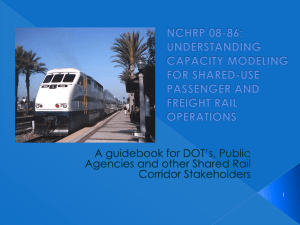



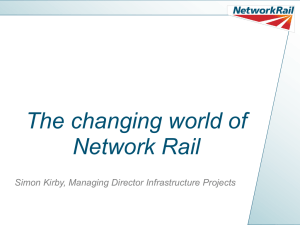
![lecture_8_(2)lscm[1] - Head Scratching Notes](http://s2.studylib.net/store/data/005495268_1-06056aa40ae4298d0ab041c29bbcab92-300x300.png)
